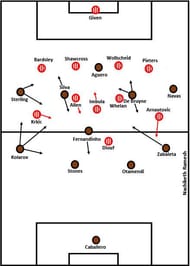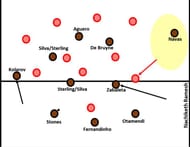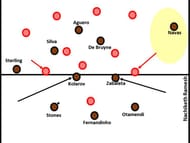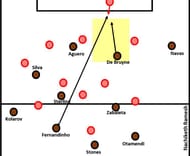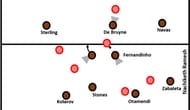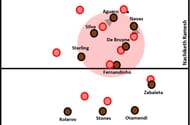Manchester City cruised past the roughest side of Premier League, Stoke City, with a score line of 4-1. Sergio Aguero scored a brace to take his goal tally of the season to six. Nolito also followed Aguero’s footsteps and netted two goals in the closing minutes of the match. Bojan Krkic scored the home team’s only goal of the game.
On a funny note, Pep Guardiola, with this win, has now partly answered one of the most daunting questions posed to him: “Can you do it on a cold, wet, and windy night in Stoke?”
Teams:
Stoke City: Shay Given; Phil Bardsley, Ryan Shawcross, Phillip Wollsceid, Erik Pieters; Glenn Whelan, Joe Allen, Gianelli Imbula; Marko Arnautovic, Mame Diouf, Bojan Krkic.
Manchester City: Willy Caballero; Aleksandar Kolarov, John Stones, Nicolas Otamendi, Pablo Zabaleta; Fernandinho; Raheem Sterling, David Silva, Kevin De Bruyne, Jesus Navas; Sergio Aguero.
Guardiola, like in the previous games against Sunderland and Steaua Bucuresti, went ahead with a 4-1-4-1 formation. Mark Hughes’s Stoke looked like a 4-3-3 on paper. It was more of a 4-5-1 formation than the former.
Since the focus is mainly on Manchester City, the analysis will be 80% aimed at looking at the different mechanisms of Guardiola’s team and only around 20% on the dynamics of Hughes’ Stoke City.
Manchester City’s shape – Situational Inverted or false fullbacks, Sterling the central supporter and Great movements
Guardiola’s team was again changing from a 4-1-4-1 shape to a more flexible back three in a 3-2-4-1 which was also offering City the ability to hold-up the key positions as per the manager’s plan.
3-2-4-1! But that was the same one used against Sunderland last weekend, isn’t it? Partly yes and partly no.
Yes, because it was a 3-2-4-1 against Sunderland.
No, because the players who occupied the positions were different and the movement mechanisms of the players from the original formation to morphed formation were also quite altered.
For example, Sterling started on the left today where Nolito had started against Sunderland. Unlike Nolito, who was moving central in tandem with Silva’s outward runs in the final third and only a few times in the middle third, we saw Sterling getting involved more in the build-up play by moving towards the central regions and helping in providing numerical superiority during the build-up phase.
It was the same with the wingbacks, Kolarov and Zabaleta, and the manner in which they moved and occupied the center. There was a pattern.
Against Sunderland, both Gael Clichy and Bacary Sagna were cutting in towards the center circle during the possession phase of Manchester City. But against Stoke, the wingbacks of City behaved slightly differently.
When the build-up was happening on a particular wing and if Fernandinho was staying ahead of the defenders, City was changing to back three with the ball near side wingback occupying the half-space as a center back. In order to be compact and provide support to receive passes, the far side wingback was moving central and thus, was changing to a false or inverted fullback.
There was another scenario. This was when Fernandinho was dropping to split the center backs, Stones, and Otamendi, during the build-ups. With Stones, Fernandinho, and Otamendi forming the back three, it was up to the near side wingback and winger to decide about the movements. Either the winger was moving in towards the center or it was the wingback, thus becoming an inverted fullback.
The player who was moving central was being joined by either Silva or De Bruyne (depending on which side the build-up was taking place) and by the far side wingback (as an inverted fullback).
This had some advantages. One, as mentioned in the explanation, City was gaining numerical superiority in the middle to pass the ball through the central strip.
The other was, this numerical superiority and accompanying movements of Aguero, Silva, Sterling, De Bruyne, and the wingbacks were dragging Stoke City’s defensive shape towards the wing or half-space where the build-up was taking place. This was freeing up space for the winger on the far side of the field – enabling diagonal balls to be played.
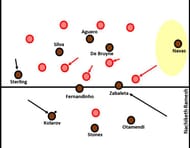
So by flexible movements, City was able to maintain two central players – either in the center or in the half-spaces adjacent to them. Keeping aside the normal numerical advantages and passing options for ball circulation, City players, with their coordinated and almost synergistic in and out movements, were confusing the Stoke defenders.
The right-back, Bardsley, was tracking Sterling whenever the English winger was moving towards the center or dropping deep. Silva, combined with Aguero, was putting the defensive midfielders and the central defender in doubt.
Tracking was the only option for the Stoke players and such actions were exposing the center open for attacks via through balls. Two especially caught my attention – one in the fifth minute and one in the 68th minute – both by Fernandinho and both were as a result of manipulated defensive structure of Stoke City due to Manchester City’s movements.
The flaw

The system wasn’t always productive for Manchester City. One wrong positional choice from the players was costing the shape and structure, allowing Stoke City to press aggressively for the ball.
Zabaleta, for one, tried to move higher up the pitch to draw Stoke’s defensive midfielders narrow and then open spaces for De Bruyne and Silva using lay-off back pass to Fernandinho. But it failed since he didn’t move high enough to receive such a pass in between Whelan and Allen.
Moreover, his positioning resulted in cover shadowing of De Bruyne and marking of Zabaleta easy and single job for the opponent.
Also, City had 6 players in two lines, which is not such a good positioning when positional play demands players at different depth and width to stagger the structure of a team in possession in order for better ball retention and penetration.
Navas, whose primary job was to stay wide and stretch the defense while the rest of the visiting team’s players were playing on the left side, was seen cutting in a few times. He eventually ended up being dispossessed and confused Zabaleta as well, who was mostly staying narrow.
City counter-pressing
Counter-pressing or the pressing done as soon as ball possession is lost in order to prevent the opponents from counter-attacking is one of the key elements of the Guardiola’s teams. At Barcelona and Bayern Munich, both the teams were tuned to press aggressively and effectively to win the ball back as quickly as possible.
Guardiola himself asserted his trust in counter-pressing during a recent interview: “I want the ball for 90 minutes. When I don't have the ball, I go high pressing because I want the ball.”
It is no doubt that his new team, Manchester City, is also starting to counter-press the opponents to great extents. While they have not been entirely perfect, in the sense players blocking the right passing lanes etc, but there were some good examples of City’s passing lane oriented counter-pressing.
In passing lane oriented pressing, the pressing team tries to block all the passing lanes of the ball carrier with the use of cover shadows. When Stoke City attempted to counter attack, City covered the ball carrying opponents from all possible angles to shut down his passing options – forcing the player to hold on to the ball or pass long.
As City’s attacks were getting thwarted in the high middle third, it was quite necessary for the visiting team to counter-press in order to deny the home team any chances of playing long and bypassing most of the City players in the process. The pressing, so as to win the ball back quickly, started from the very first line – led by Aguero and followed up by the players in the subsequent lines.
Manchester City defended with a 4-1-4-1 during Stoke’s possession phases. But to counter-press, City needed traps to lure the opposition players into. In order to create such favorable situations for counter-pressing, City players used layered structure.
This increased the triangles between players thus allowing them to close down on a particular ball carrying opponents present in between the City players. Also, such compact layered structure was driving Stoke’s players away towards the spaces where City was not compact but still had qualitatively superior players – like playing a long ball away from a compact space towards the forwards, which was getting intercepted by City’s defenders.
Winning the ball by counter-pressing was putting City in a commanding position. Since Stoke City was trying to make most of the possession by attacking quick, it was losing nearly four players when City players were winning the possession back in the middle third.
This was leaving the remaining players in situations where City had both numerical and qualitative superiority. Through these two, City was also gaining central access – thus the positional superiority as well. Such situations were leaving Stoke City vulnerable to quick passing and space opening leading to chance creations by the visiting team.
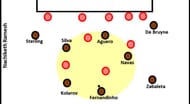
Stoke City’s response in second half
Stoke City was more aggressive and less passive than it was in the first 45 minutes of the game during the second half. With the intention of getting a goal back and then attacking for more, tried to make the most of its possession phase by targeting space through directness in attack.
In the build-up phase of Manchester City, Stoke was more involved as it attempted to deny safe passage for the visitors in their defensive third. The high-pressing was partly successful as Caballero was tested a few times. However, with space in the middle and free players like Silva were helping Fernandinho by forming a temporary or situational double pivot in order to bring the ball out with numerical superiority.
Lessons learned from the game
Manchester City is one step ahead of where it was last week. Better build-ups, positioning, flexibility in the attacks, pressing, compactness without the ball. However, a quick-footed and ball playing goalkeeper will surely help the team.
We saw today that Stoke’s direct play was landing the ball in front of City’s penalty box -where there were a few tense moments and luckily City didn’t concede in such scenarios. But these can be avoided by a sweeper keeper who is confident enough to anticipate passes and move out of the box to clear or collect and continue the play and help in attacking scenarios.
Although it was a huge win, there were a few on-field communication problems amongst the players – Sterling, however stellar his performances might have been, struggled to sense his next move and just looked around for Silva for a second or two (who actually was right behind him).
A clear understanding still needs to be developed amongst the players with respect to the system of play used and trained under Guardiola. With so many positional rotations and dynamic positioning players need to have a good level of verbal and non-verbal communications with each other.
All these can only develop with more training sessions and better involvement. That said, a win such as this boosts confidence which can only spur everyone involved at the club to learn and adapt quickly.
